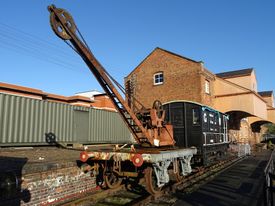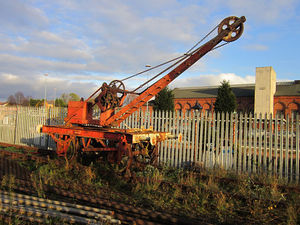GWR 601 1Ton 10cwt Hand Crane
| GWR 601 1Ton 10cwt Hand Crane | |
|---|---|
 GWR 601 1Ton 10cwt Hand Crane (2019) | |
| Built By | Cornish Railway (rebuilt by GWR) |
| Status | Static display |
| Number | GWR 601 |
| Other Numbers | 6685, 14959? |
| History | |
| Built | Unknown (rebuilt 1892) |
| Type | 4-wheel hand crane |
| Capacity | 1 ton 10 cwt |
| Brakes | Unfitted |
GWR 601 1Ton 10cwt Hand Crane is on static display at Kidderminster Railway Museum.
Contents
Contents
History
According to the GWR registers held at the National Railway Museum, this crane was one of several originally built at an unknown date as broad gauge cranes for the Cornwall Railway and numbered in the 668n series.[1] The Cornwall Railway opened in stages from 1859 and ran from Plymouth to Falmouth. It was eventually acquired by the GWR in 1889,[2] with the cranes being handed over to the GWR at Saltash in June of that year.
Following the acquisition by the GWR, the cranes were rebuilt to standard gauge in 1892 and re-numbered in the 149nn series. In 1895 they were further re-numbered in the 60n series. They continued in Departmental use with the GWR and later with BR until the 1980s. Their broad gauge origins make them probably some of the oldest GWR vehicles in preservation[1][3].
Preservation
The GWR 813 Preservation Fund acquired two of these cranes from BR(W) in 1982. An article in the Fund’s summer 1997 newsletter suggested that the one at the SVR was No 602 (ex-6687 / 14960) and the other, then stored at the Plym Valley Railway, was No 603 (ex-6688 / 14961). The article also noted the existence of a third such crane at the South Devon Railway, not owned by the Fund, which was thought to be No 601 (ex-6685 / 14959). However a postscript in the same newsletter noted that an "identity crisis" had emerged over the SVR-based crane, with the number 6685 having been found stamped on the solebars in at least four locations.[1]
A subsequent article in the summer 2000 newsletter noted that the identity of the crane at the South Devon Railway had been established as 610 rather than 601. As the GWR registers confirmed the history of No 6685 becoming No 601, the Fund therefore concluded that the crane at the SVR was No 601, with the true identity having become confused at some stage during BR ownership. However the Fund’s website and the Railway Heritage Register Wagon Survey both give the first GWR number as 14960, although the original article suggests it was 14959.[3]
The crane is on display on a short section of track adjacent to Kidderminster Railway Museum.
